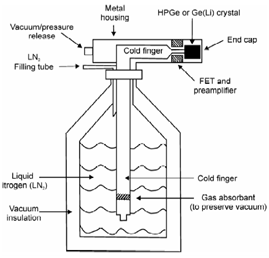Resolution of a detector:
The resolution of a detector measures its capability to resolve adjacent gamma rays. It helps to eliminate unwanted gamma rays near the photo peak of interest. Another important parameter characterizing gamma ray detector is the efficiency which measures the fraction of incoming gamma rays of any given energy that contribute to the corresponding photo peak. Ideally a detector should have as good a resolution (low R) and as higher an efficiency as possible. Both these requirements are fulfilled by high purity germanium (HPGe) detector which has much superior resolution (improved by a factor of more than 50) though its efficiency is somewhat lowered. However, in recent years high efficiency HPGe detectors have become available.
These are attached to a large cryostat which makes them bulky and difficult to handle. Schematic diagram of a typical HPGe or Ge (Li) detector with Dewar attached to it is shown in Figure. Such detectors are usually characterized by their resolution, efficiency, and peak-to Compton ratio.

Figure: Schematic diagram of high purity germanium (HPGe) or Ge (Li) detector with liquid nitrogen Dewar